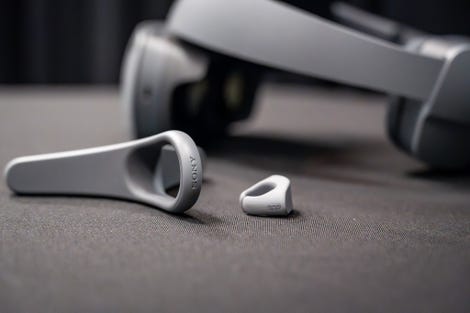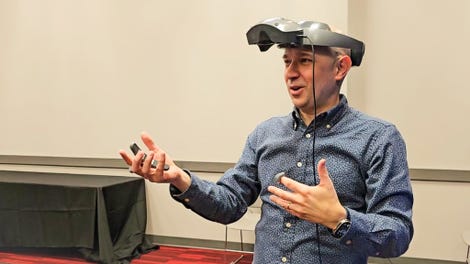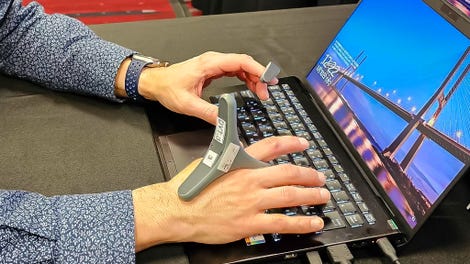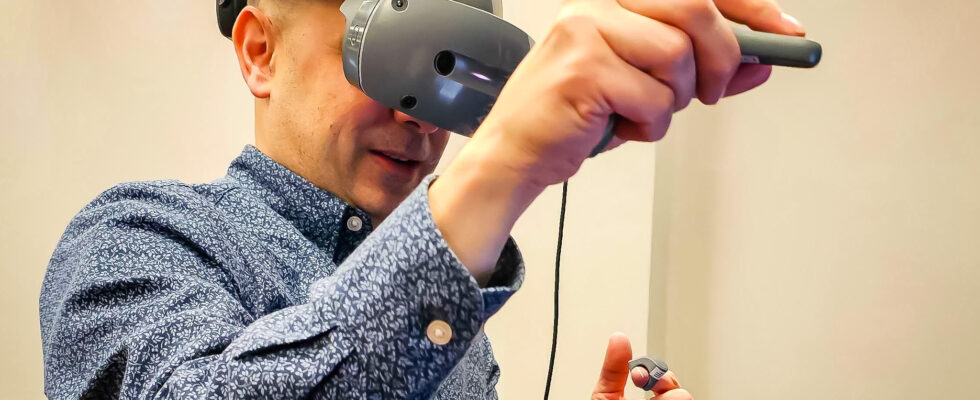I tried out the Sony XR headset and its portable controllers at CES 2024. Jason Hiner/ZDNET
In one of the dark hallways at the back of the Las Vegas Convention Center, a respectable distance from the pristine Samsung and LG booths, I found an anonymous room.
In this ordinary room, a few chairs and a few folding tables, and a projection screen. And a high-powered laptop connected, via a long black USB-C cable, to headphones. Yes, I was entitled to a private demo of the product that was the biggest surprise of CES 2024, Sony’s XR headphones. And I even got to chat with some of the proud employees involved in this product.
As a reminder, Sony’s XR headset burst onto the scene during the CES 2024 opening keynote, just hours after Apple announced availability and pre-order information for its highly anticipated Vision Pro headset.
The headset features an 8K display
Sony’s headset is the first to use Qualcomm’s new XR2+ Gen 2 chip, which aims to allow hardware makers to produce high-end XR devices to compete with Apple’s Vision Pro. Most of these Qualcomm XR2+ Gen 2 headsets will run Android, and Sony confirmed to ZDNET that the same is true for its product.
The headset features an 8K display using 4K OLED microdisplays for each eye. It also includes a pair of handheld controllers, a ring and a pointer, which enable precise selection and efficient manipulation of 3D objects in virtual spaces.
The idea is to hold the pointer in the dominant hand and the ring in the other hand. The headset also has a flip-up screen that makes it easy to leave and return to a session, a feature all headsets should offer.
What is it for and how does it work?
My interview with Sony and Siemens (because the headset for now works with the German giant’s software and packages) also confirmed that the headset is focused on two things:
- Help engineers, designers, and product managers accelerate product development by creating “digital twins” (virtual versions of real products) to streamline mockup creation, collaboration, and approval.
- Enabling the next generation of content creators to create immersive spatial experiences, including 3D and XR (eXtended Reality) entertainment that will ultimately populate Vision Pro, Meta Quest and other headsets and smart glasses.
Sony’s headset doesn’t have an official name yet, and there’s a good reason for that.
This is not a standalone headset
It will not be sold as a standalone device, but as a solution built with Siemens NX Immersive Designer, software that companies will use to create, collaborate, iterate and manipulate product designs across global teams . This will therefore save enormous amounts of time and resources by replacing, among other things, long employee plane trips or sending physical prototypes around the world with collaboration in virtual spaces around pre-defined “digital twins”. -cited.
Sony will also have other partners who will integrate their software platforms into the headset in order to sell them to specific verticals and industries. Sony has focused on the entertainment industry, in which it has deep roots, and plans to use the headset as a “spatial content creation platform” that will put tools in the hands of filmmakers, games and other storytellers to create a new wave of immersive content.
The headset will also include Sony’s proprietary motion capture system, called “mocopi”, which allows for full-body tracking. This makes it a powerful platform for computer graphics and 3D animation.

The wearable ring and pointer are some of the most unique features of the Sony XR headset. Jason Hiner/ZDNET
My first impressions with the Sony XR headset
When I first put the helmet on, it felt comfortable and balanced very well on my head. The ear cushions weren’t as soft and cushioned as those on Apple’s Vision Pro, but it wasn’t as heavy either. I immediately loved the folding screen, just as much as that of the Lynx R1 (which Sony clearly took inspiration from) and even more than the folding face straps like those from BoboVR compatible with the Meta Quest.
The virtual environment I was immersed in looked like a museum wing, with its columns and sculptures, and gave the impression of being in an impeccable space. Half a dozen objects floated in front of me: a camera (Sony Alpha, of course), a sheet of type that looked like it came from a ledger, a photograph, an art print, a page of scientific equations with white characters on a black background, and a few other objects.
I was able to grab the camera, spin it around, and press the shutter button to take a photo of anything in the digital environment. The image I then took floated above the camera in virtual space. I could also pick up a page of text and read it clearly from about 2 feet to 6 inches from my face. The text was perfectly crisp and clear. This is where the 8K display showed its value.

The flip-up screen makes the Sony XR headset very user-friendly for developers and professionals. Jason Hiner/ZDNET
Screen fidelity and resolution were excellent
Overall, the screen fidelity and resolution were excellent. Great sharpness and contrast, good colors, the display was incredibly smooth and fast when I turned to look at other things. I have used and tested many headsets and the quality and performance of the Sony headset is rivaled only by the Apple Vision Pro and the Varjo XR4.
Let’s talk a little about handheld controllers. The ring and pointer have very high pointing precision, as well as intuitive buttons for selecting items. The difference between using them and using hand tracking (in the case of the Vision Pro) seems to be a matter of gross motor skills versus fine motor skills. In other words, it’s like the difference between picking up an apple (Apple) and picking up a penny! There are a lot of things people will be able to do with hand tracking alone. But for more precise uses, the ring and pointer make a lot more sense.
One of the coolest things I discovered is that the pointer slides over your finger and the main part sits in your palm when using it in XR mode. But when you switch to using a keyboard on your computer, the pointer moves and can rotate to the other side (the back) of your hand. It’s very natural and intuitive. My only small complaint is that I wish the ring was a little looser and more adjustable around my finger. Also, let the pointer be a little more comfortable around my index finger.

The portable pointer flips to fit on the back of the hand when switching to a traditional keyboard. Jason Hiner/ZDNET
Load sharing with a computer
One thing I didn’t expect was that the headset also connected to a laptop. Although the headset has its own processor and runs Android, Sony says it also requires the USB-C connection to a laptop in order to power the Siemens NX Immersive Designer software. Sony calls this “split-rendering” and says it balances the load between the headset and the computer, allowing stable rendering of high-resolution 3D objects.
Finally, I would like to point out that this was a brief demo with only a few simple scenarios. It wasn’t nearly as in-depth or as diverse in experiences as the Apple Vision Pro demo I did at WWDC 2023. Still, the fidelity and smoothness of the user experience was quite impressive. And as I have already written, Apple could draw inspiration from what Sony has created for its Vision Pro to better meet the needs of professionals.
Source: “ZDNet.com”
